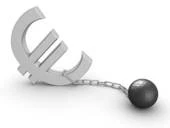Why are many firms still currently so cautious in business outlook? One likely factor is that they regard the present stale economy as highly uncertain, particularly in the US and Europe. The recent combination of volatility and a declining trend in developed-world stockmarkets has reinforced concerns that already abounded in companies’ executive suites, that the recovery so far has relied too much on government spending. That, given all the recent political talk about the need for public austerity to fend off bond-market vigilantes, may not continue. Meanwhile, private-sector demand remains anaemic.
A second factor is that firms have much less need to invest now because their capacity utilisation remains at historically low levels, so you do not need more resuorces as you got nothing much to output as demand is still slow in picking up. Currently, for example, industrial-capacity utilisation in US is 73%. That is up from the recessionary low of 69%, but well below the 80%-plus level it was at in the years before the economic meltdown in September 2008, and during much of the 1990s. Since plants still have so much spare capacity, managers see little justification for capital spending. It is forecasted that in developed countries, industry’s capital spending will fall by 3% this year after a 10% fall last year. In emerging markets, capex is expected to grow by 8% this year but far short of last year’s roaring 21% growth.
MARKETS seem to be emerging from a bad patch of turbulence and the past two months have seen wild swings across global financial markets that would have unsettled even the most seasoned of investors. Europe may have averted disaster but its sovereign debt problems are far from over. In China, the yuan is finally unshackled from the dollar but it remains to be seen how far it will be allowed to gain on the greenback.
 For sure, a range-bound market characterised by much volatility was pretty much a given this year as the global economy faced its biggest test since the depths of March 2009. With government stimulus petering out, the question was always whether private investment and consumption had mended sufficiently to take over the mantle of championing global growth. Strong emerging market growth is set against lagging expansion in the West, while Asia's inflation-fighting policy-makers square off against Europe's fiscally tied hands.
For sure, a range-bound market characterised by much volatility was pretty much a given this year as the global economy faced its biggest test since the depths of March 2009. With government stimulus petering out, the question was always whether private investment and consumption had mended sufficiently to take over the mantle of championing global growth. Strong emerging market growth is set against lagging expansion in the West, while Asia's inflation-fighting policy-makers square off against Europe's fiscally tied hands.As it stands, Asian governments, faced with the threat of inflation, have started to normalise fiscal and monetary policies. China, in particular, has moved fairly aggressively to curb the rapid rise of real estate prices. In contrast, those in the West have been fairly content to retain stimulatory policies - at least until Europe's sovereign debt crisis erupted. Beginning with what seemed like a peripheral problem, the continent - and the world - was sucked into a spiral of anxiety as sovereign solvency fears spread beyond Greece. Efforts by EU policy-makers appear to have successfully stabilised the contagion.
In second half of 2010, the global recovery could be on track and fears of a double-dip recession are likely overstated. Concerns that Europe's fiscal problems may spark a liquidity crunch of post-Lehman proportions might be fast fading, and upcoming stress-test results for the region's banks should go some way towards nullifying those fears. While banks are lending to one another at higher interest rates, perceiving greater counter-party risks, the actual risk premiums demanded are not worryingly high by historic measures. In any case, the European Central Bank appears committed to pump in as much liquidity as is needed to prevent a shortage.
On the other hand, medium-term worries about an over-leveraged global economy are probably warranted. Public debt in the developed world has ballooned as governments deploy massive amounts of fiscal stimulus to prop up economic activity. Fiscal deficits are starting to reach unsustainable levels that necessitate spending cuts that are likely to be a drag on economic growth, especially in the industrialised nations, for many years to come. Still, the effects of such fiscal tightening are unlikely to be felt immediately and may well be overcome eventually by gathering momentum in the global recovery.
Indeed, emerging markets, especially in Asia, are likely to continue to grow strongly, and that seems to be underscored by China's move to allow greater flexibility in the yuan exchange rate. While actual latitude for yuan appreciation has been fairly limited and gradual, the policy change seems to signal that policy-makers are at least more confident about the outlook for the domestic economy. In addition, monetary tightening in Asia may be delayed. Europe's sovereign debt problems are likely to prompt policy-makers to be a tad more circumspect about global growth, and hold off raising rates until later in the year, or even next year. In the US, momentum from the first half of the year is expected to be sufficient to keep activity growing through the rest of the year, albeit at a more moderate pace. Unsurprisingly, Europe is set to bring up the rear. Growth is expected to be sluggish as fiscal tightening is expected to be a significant drag even into 2011.
Economic contraction is often thought to cause corporate revenue and earnings to fall sharply, missing current forecasts. On examining major double dips in various markets in the past 30 years, it is believe that markets may be too focused on the top line. Company profits, then, are likely to be more resilient than expected, even if the economy tanks again.
Current price-earnings valuations seem to imply a brutal double dip in which the economy contracts even more than in 2008-009, down one per cent in nominal GDP terms in both 2011 and 2012. Even in such a severe scenario, corporate earnings would be expected to grow more than 10 per cent in 2010, before declining 10 per cent in 2011 and 2 per cent in 2012 - much less than the 56 per cent plunge in 2008-09.
Still, it could take some time for markets to realise that a double dip is not a probable scenario and that corporate earnings are likely to be more resilient if it does happen. In the meantime, volatility is likely to persist, calling for nimble toes - and fingers, while an uneven recovery warrants judicious market selection and stock-picking. These moments of volatility may yield good trading opportunities - and are unlikely to derail the fundamentally bullish long-run outlook for emerging markets. Even if China, and Asia overall, prove unable to escape the cycle of bubble, these economies remain well-placed to continue strong growth over the next few decades. Against this backdrop, emerging markets remain preferred over developed ones, as investors are likely to recognise their strong economic fundamentals and keep capital flowing into these more vibrant markets. Among the developed markets, the US is looking the most attractive, buoyed by robust economic momentum of its economy.
In conclusion, balancing risk to opportunity is going to be key to portfolio performance where equity markets are expected to remain volatile and range-bound for at least the rest of the year. Even though we remain optimistic about the long-term prospects for emerging markets, especially in Asia, and remain cyclically positive on the US, events in Europe do present significant short-term threats to the recovery. In this scenario, it is even more important to ensure that diversification and regular risk assessments remain a fundamental anchor to ensure balanced growth in one's portfolio in these interesting times.

















